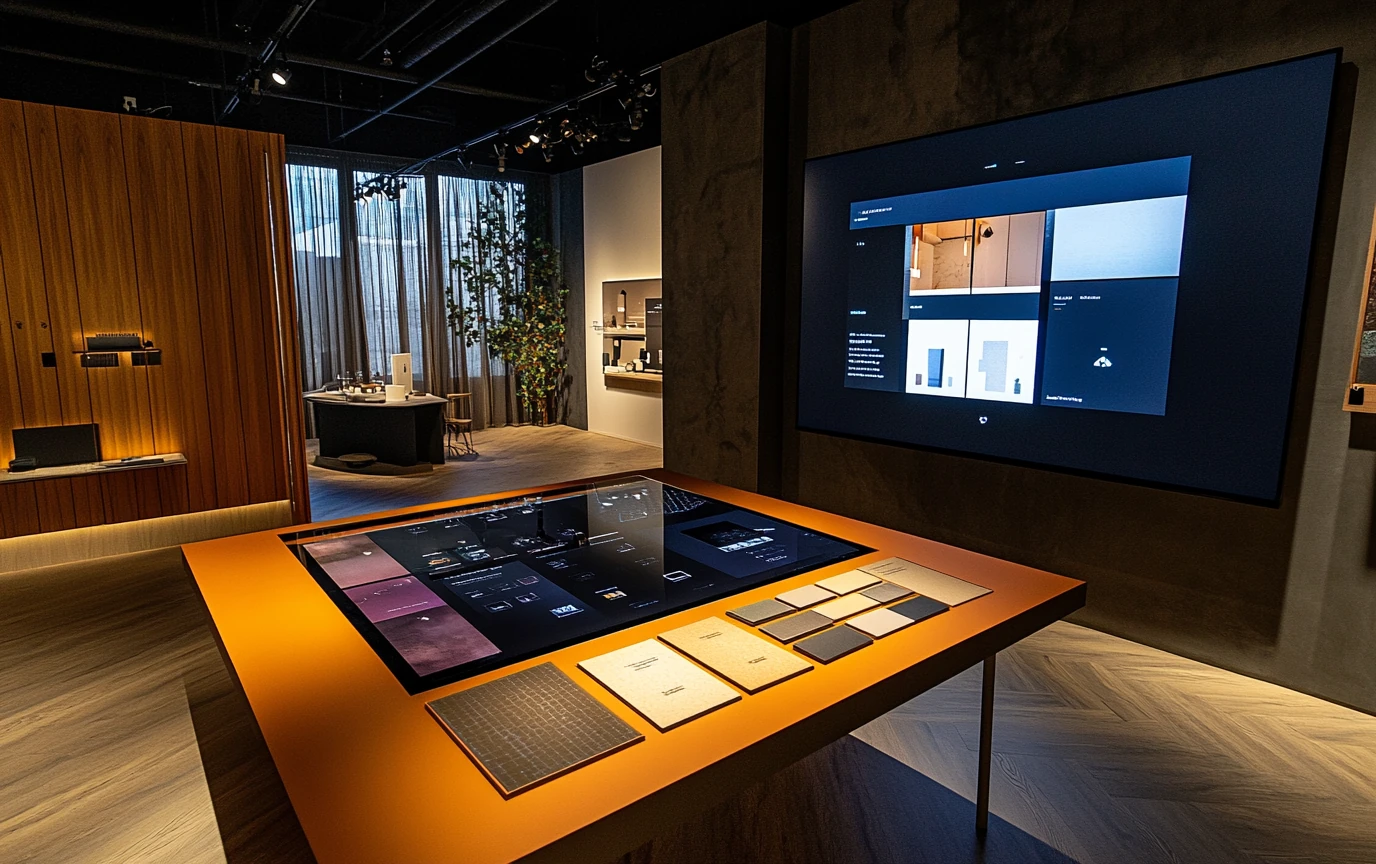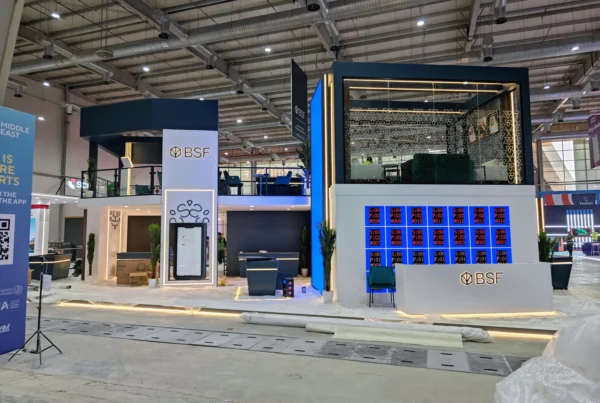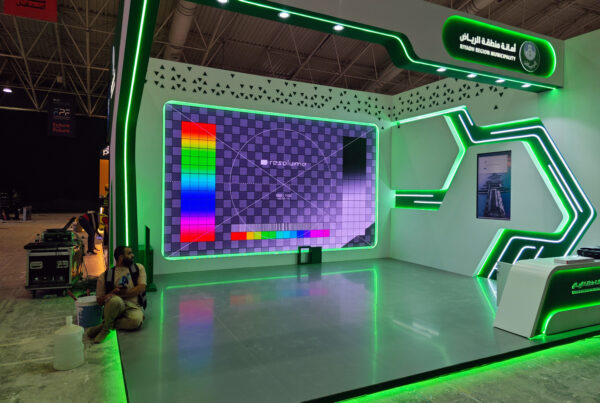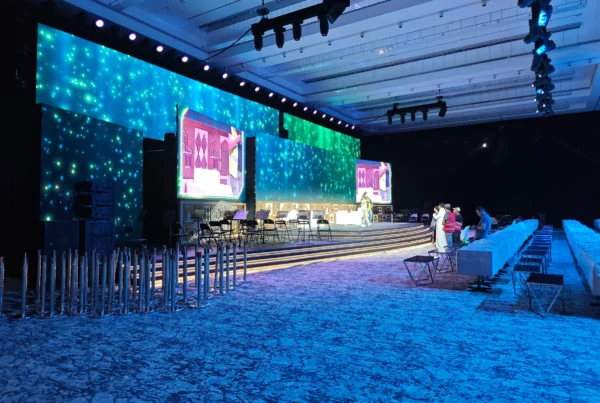From visionary off-plan real estate in Riyadh and Jeddah to high-end automotive showrooms catering to discerning Saudi consumers, the Kingdom of Saudi Arabia (السعودية) is witnessing a transformation in how brands engage customers. At the heart of this evolution lie immersive showrooms—spaces that leverage digital twin innovations, user-centric design principles, and respect for local norms to create unforgettable brand interactions. In this article, we’ll dissect the elements of these interactive experiences, clarify their cultural and technological significance, and offer practical strategies for harnessing them to drive sales, excitement, and loyalty in Saudi Arabia.

1. Saudi Arabia’s Changing Landscape: Why Immersive Showrooms Now?
1.1 Rapid Growth Under Saudi Vision 2030
Under Saudi Vision 2030, major cities such as Riyadh and Jeddah have embarked on large-scale development projects—ranging from cutting-edge business districts to ambitious off-plan residential communities. While consumer appetites expand, competition to stand out becomes fiercer. Developers and automotive brands alike seek advanced marketing channels that demonstrate tangible value and authenticity. Traditional showrooms or 2D presentations increasingly struggle to meet these expectations.
1.2 The Power of Interaction and Local Custom
A hallmark of Saudi society is the emphasis on hospitality, personal connections, and communal gatherings. Accordingly, brand encounters that center on in-person experiences—guided by interactive technology—tend to resonate. Whether unveiling luxury sedans or a new condominium tower, visitors expect an environment that speaks to them intimately, reflecting both Saudi cultural traditions and the Kingdom’s leap toward tech-savvy experiences. Consequently, immersive showrooms thrive by blending cutting-edge visual solutions with a deeply user-centric approach.
2. Defining an Immersive, Interactive Showroom
2.1 Moving Beyond Conventional Space
An immersive showroom does more than house static displays or promotional brochures. Instead, it harnesses live data, augmented or virtual reality, multi-sensory touchpoints, and dynamic storytelling methods. This approach not only cultivates emotional engagement but also empowers visitors to explore product features or properties on their own terms.
For instance, a developer might install digital twin stations where buyers can see entire floor plans reconfigure at a click—an immediate advantage over static maquettes. Or an automotive brand might let prospective customers “test drive” new models via VR simulations that realistically mirror Riyadh’s cityscapes.
2.2 Blending Tech with Local Aesthetic
Cultural alignment remains crucial in Saudi Arabia. Consider weaving in Arabian design motifs, Arabic-language signage, or comfortable majlis-style seating areas to encourage thorough brand explorations. Integrating advanced technology with local environment fosters synergy, letting visitors appreciate the brand’s respect for tradition while experiencing the marvel of immersive solutions.

3. Digital Twin Technology: Core to Interactive Success
3.1 From Static to Data-Driven
Traditional 3D models are visually impressive yet static. Digital twins go further by syncing real-time data—like occupant analytics or equipment status—to create a living, breathing model. This dynamic element can drastically enrich showrooms, whether for off-plan real estate or new car line-ups, allowing prospective buyers to see how lighting changes throughout the day, or measure occupant flows in a future mall concourse.
If you want to explore how these cutting-edge technologies can revolutionize your showroom concepts, consider digital twin solutions for more background on how data integration drives lifelike simulations.
3.2 Bridging the Gap with Interactivity
In an immersive showroom, digital twin elements can be manipulated by visitors. For instance:
- Unit Customization: Off-plan buyers can switch apartment layouts or finishes, seeing immediate updates in real time.
- Automotive Demos: Car shoppers can “walk around” or “test drive” a model in various Saudi road settings, toggling engine types or color schemes.
- Live Updates: If occupant behavior or climate data is fed into the twin, it can illustrate more accurate occupant comfort or energy usage metrics.
These interactive layers speak directly to user-centric design, akin to ideas discussed in User-Centric Strategies: Mapping the Customer Journey in an Interactive Showroom.
4. Off-Plan Property Marketing: Making the Unbuilt Tangible
4.1 Overcoming Abstract Blueprints
Skepticism often surrounds off-plan developments in fast-growing Saudi cities like Riyadh—buyers want to see tangible evidence of a future project’s layout, views, and amenities. With immersive showrooms:
- VR-Based Exploration: Visitors “tour” prospective units in real-time 3D, analyzing how rooms connect and viewing potential cityscapes from upper floors.
- AR Tools: Sales teams can overlay finishing options or furniture sets, letting prospective buyers instantly see how final designs align with personal preferences.
By letting clients feel the project’s layout—beyond static renderings—developers can drive earlier commitments and deeper emotional investment, boosting sales velocity.
4.2 Creating an Engaging Launch
Borrowing from event-based tactics, some developers adopt “mini expos” for property launches. They might fuse digital twin insights with live stage presentations to highlight the building’s occupant flows or day-night transitions. According to Fusing Digital Twins with Events: The 2025 Digital Interactive Experience That Elevates Real Estate Engagement, such synergy can push marketing from a static booth to a dynamic encounter that garners media coverage and immediate buyer interest.
5. Premium Automotive Showrooms: Interactive Journeys in Jeddah and Riyadh
5.1 Rethinking Car Dealerships
Luxury and sports car brands in cities like Jeddah value exclusivity and spectacle. An immersive automotive showroom might incorporate:
- AI-Powered Virtual Drives: Potential customers select a model and “drive” it in an interactive VR environment simulating local streets—like the Corniche in Jeddah or bustling areas in Riyadh.
- On-Demand Customization: Real-time occupant analytics record interest in various upgrades, fueling targeted follow-up.
Smart interactive solutions—like those described in Scaling Up Your Strategy: Best Practices for Implementing a 2025 Digital Interactive Experience on Any Budget—help dealerships scale these enhancements, balancing the “wow” factor with cost considerations.
5.2 Aligning with Local Customs
From gender-segregated considerations to modest attire guidelines, a brand event in Saudi Arabia must respect societal norms. An automotive showroom might include separate viewing zones for women drivers or a private VR station. By acknowledging these local nuances, immersive engagements remain comfortable and respectful, yielding positive brand reputations.
6. User-Centric Design: Cultural Nuance and Emotional Hooks
6.1 Hospitality and Memorable Encounters
Saudi traditions emphasize warm welcomes and communal ties—mirrored in the brand’s approach to immersive showrooms. From greeting visitors with Arabic coffee to setting up a majlis-inspired lounge for informal discussions, small gestures foster genuine user-centric relationships. This approach pairs well with the advanced technology that prospective buyers now expect in a rapidly modernizing environment.
6.2 Emotional Connectivity
By letting customers “experience” a project’s essence—like an upcoming retail complex or an exclusive high-rise—brands tap into emotional impulses. As Why Experiential Marketing Resonates with Gulf Audiences points out, shared, immersive experiences drive strong word-of-mouth. The local preference for in-person events amplifies the effect, as successful launches quickly spread through social networks, forums, and personal recommendations.
7. Operational Insights: Live Data for Lasting Impact
7.1 Tracking Engagement
A hallmark of immersive showrooms is the ability to collect occupant analytics in real time, similarly to advanced occupant-tracking discussed in AI Takes Center Stage: How 2025’s AI Revolution Will Transform the Digital Interactive Experience. Using digital twins, you can measure:
- Visitor dwell times at each exhibit or portion of the showroom.
- Finishing Preferences: If multiple AR-based color schemes exist, data reveals the most popular choices among Riyadh’s prospective apartment buyers.
- Conversion Pathways: Staff see which paths—like VR test drives or personal guided tours—translate into the highest lead conversions.
7.2 Post-Launch Utility
Even after a property’s official opening or a car’s local unveiling, the digital twin framework can remain operational, updating occupant experiences or gathering feedback for future enhancements. This post-launch approach fosters brand loyalty, maintaining showrooms as “living” marketing tools rather than static, quickly outdated setups.
8. Measuring ROI in Immersive Showrooms
8.1 Conversions and Deposits
For off-plan real estate in Saudi Arabia, one direct measurement is how many prospective visitors place down payments or sign purchase agreements soon after exploring immersive showrooms. If an automotive brand, on-site test drive bookings or new model reservations can be an equally telling metric.
8.2 Marketing Reach and Buzz
Social media shares, local influencer coverage, or mainstream media references also demonstrate an immersive showroom’s success. In a region where influential families or high-profile visitors can accelerate brand acceptance, these intangible brand lifts are crucial.
8.3 Occupant and Investor Satisfaction
If an interactive showroom transitions into an occupant amenity—like a VR lounge for building residents—it can yield occupant satisfaction scores. Similarly, investor satisfaction might rise if data clarity from digital twins shortens decision timelines, giving them confidence in local projects.
9. Overcoming Potential Obstacles
9.1 Budgeting for High-End Immersion
Developing advanced VR stations, digital twin kiosks, or occupant analytics systems can be capital-intensive. Adopting a pilot approach—similar to that discussed in Scaling Up Your Strategy: Best Practices for Implementing a 2025 Digital Interactive Experience on Any Budget—allows incremental scaling without incurring massive upfront costs.
9.2 Technical and Cultural Barriers
Bringing digital twin solutions to a sophisticated local market requires specialized skill sets. Partnering with experts in digital interactive solutions—like those highlighted in Smart Interactive Solutions—helps smooth out complexities. Additionally, cultural aspects—such as modest dress codes, gender segregation, or local holiday schedules—should be integrated early in event planning, ensuring no missteps in brand communication.
10. Future Outlook: Immersive Showrooms in Saudi Arabia
10.1 Expanding Off-Plan Real Estate Horizons
With the momentum of Saudi Vision 2030, developers in Riyadh and Jeddah are expected to push more signature projects. Immersive showrooms equipped with AI-driven occupant analytics will likely become a standard for marketing these expansions—solidifying buyer trust in multi-phase developments.
10.2 AI and Metaverse-Like Environments
As artificial intelligence refines real-time occupant personalization, immersive showrooms may integrate “living” metaverse layers. Potentially, prospective clients anywhere in the world can co-browse a new Saudi condo or test a car model—interacting simultaneously with local staff or other remote visitors. This advanced synergy merges experiential marketing with global connectivity, further boosting Saudi’s standing in the global property and automotive markets.
10.3 Collaboration Across Industries
Showrooms might also become cross-industry platforms where real estate developers partner with automotive brands for joint showcases, leveraging shared occupant analytics or combining brand narratives. This synergy speaks to the region’s multi-dimensional projects, bridging everything from retail to tourism in a single, immersive narrative.
Conclusion
In a rapidly evolving Saudi market, marked by heightened consumer expectations and large-scale expansions, immersive showrooms stand out as a transformative solution. By uniting digital twin technologies, user-centric design, and reverence for cultural details, these spaces produce deeper emotional connections—pivotal for success in everything from off-plan property marketing in Riyadh to luxury automotive events in Jeddah.
If you’re eager to create or enhance an immersive showroom, harnessing local traditions alongside advanced interactivity, now is the time to act. Explore further in our resources, like:
- User-Centric Strategies: Mapping the Customer Journey in an Interactive Showroom
- Fusing Digital Twins with Events: The 2025 Digital Interactive Experience That Elevates Real Estate Engagement
or contact us directly to discuss digital twin solutions tailored for the Saudi market. By embedding cultural insight and emerging tech, you’ll not only capture attention but also deliver an experience that leads to sustained loyalty—ultimately fueling interactive success in Saudi Arabia’s flourishing real estate and automotive sectors.
FAQ: Immersive Showrooms & Interactive Success in Saudi Arabia
1. How do immersive showrooms differ from traditional display spaces?
They go beyond static exhibits by integrating real-time data, interactive elements, and virtual environments—often through digital twin technology. This multi-sensory approach allows visitors to engage with potential layouts, finishes, or product features in a dynamic, user-centric way.
2. Why is local cultural alignment so important for Saudi Arabian showrooms?
In Saudi Arabia, incorporating cultural touchpoints—such as majlis-inspired seating, Arabic-language displays, and hospitality practices—helps guests feel comfortable and respected. Blending these elements with advanced tech resonates strongly with local expectations of both tradition and innovation.
3. What are the benefits of using digital twin solutions in off-plan real estate marketing?
Digital twins let prospective buyers “walk through” unbuilt spaces, exploring design options and environment changes in real time. This deeper immersion fosters trust in off-plan projects, driving earlier commitments and stronger emotional connections—vital in competitive markets like Riyadh or Jeddah.
4. Is it possible to measure ROI from immersive showrooms?
Yes. Metrics like on-the-spot reservations, increased deposit rates for off-plan units, or automotive test-drive sign-ups can provide direct evidence of success. Occupant analytics—such as dwell times and user feedback—also shed light on visitor engagement, helping refine future showroom strategies.
5. What steps should I take to implement a user-centric, immersive showroom in Saudi Arabia?
Start with a clear goal—such as off-plan sales or premium automotive launches—and collaborate with specialists in digital twin solutions. Pilot a smaller-scale interactive environment to test feasibility and gather ROI data. Don’t forget to respect local norms (e.g., modesty guidelines or gender-segregated zones) and incorporate personalized hospitality experiences to appeal to Saudi consumer preferences.


